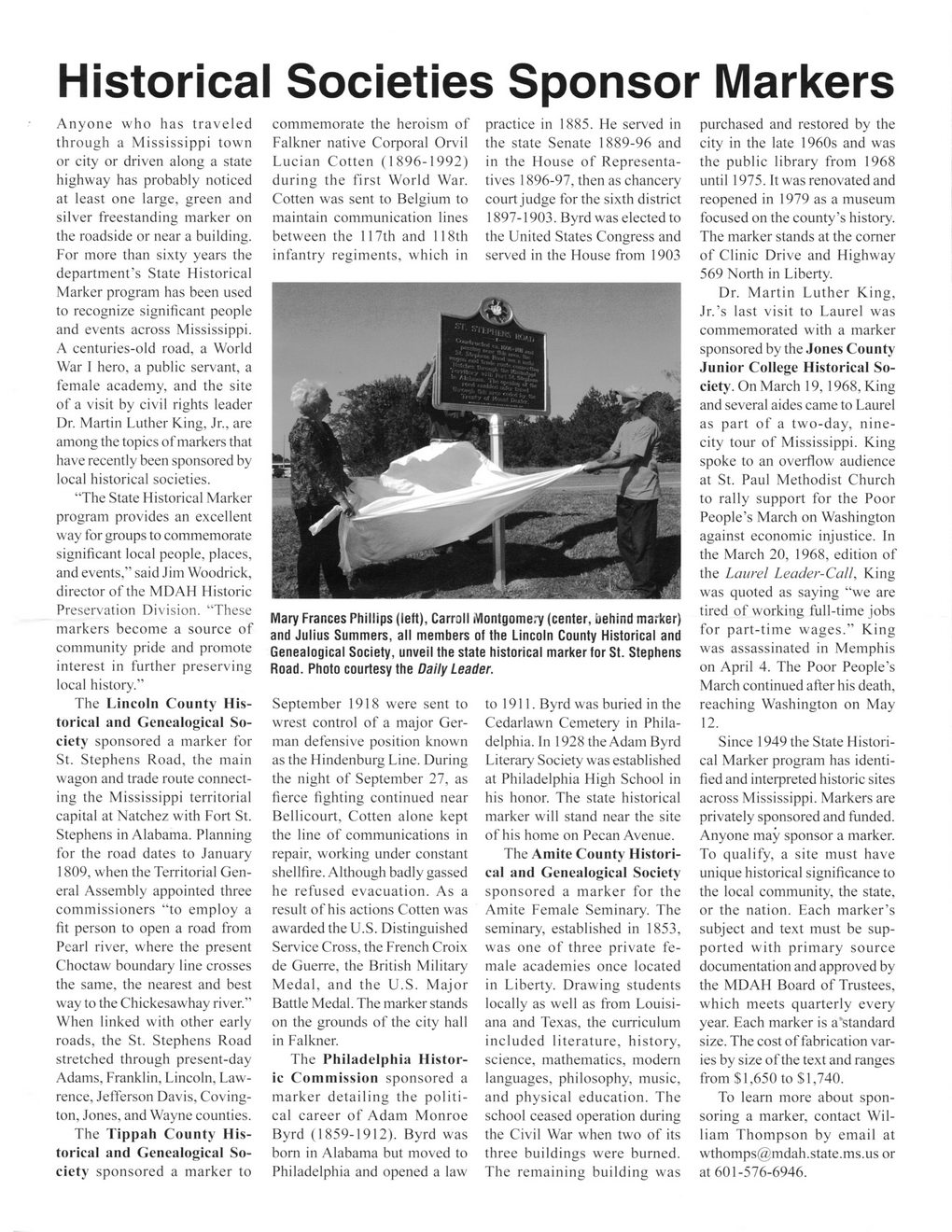This text was obtained via automated optical character recognition.
It has not been edited and may therefore contain several errors.
Historical Societies Sponsor Markers Anyone who has traveled through a Mississippi town or city or driven along a state highway has probably noticed at least one large, green and silver freestanding marker on the roadside or near a building. For more than sixty years the department’s State Historical Marker program has been used to recognize significant people and events across Mississippi. A centuries-old road, a World War 1 hero, a public servant, a female academy, and the site of a visit by civil rights leader Dr. Martin Luther King, Jr., are among the topics of markers that have recently been sponsored by local historical societies. “The State Historical Marker program provides an excellent way for groups to commemorate significant local people, places, and events,” said Jim Woodrick, director of the MDAH Historic Preservation Division. “These markers become a source of community pride and promote interest in further preserving local history.” The Lincoln County Historical and Genealogical Society sponsored a marker for St. Stephens Road, the main wagon and trade route connecting the Mississippi territorial capital at Natchez with Fort St. Stephens in Alabama. Planning for the road dates to January 1809, when the Territorial General Assembly appointed three commissioners “to employ a fit person to open a road from Pearl river, where the present Choctaw boundary line crosses the same, the nearest and best way to the Chickesawhay river.” When linked with other early roads, the St. Stephens Road stretched through present-day Adams, Franklin, Lincoln, Lawrence, Jefferson Davis, Covington, Jones, and Wayne counties. The Tippah County Historical and Genealogical Society sponsored a marker to commemorate the heroism of Falkner native Corporal Orvil Lucian Cotten (1896-1992) during the first World War. Cotten was sent to Belgium to maintain communication lines between the 117th and 118th infantry regiments, which in t September 1918 were sent to wrest control of a major German defensive position known as the Hindenburg Line. During the night of September 27, as fierce fighting continued near Bellicourt, Cotten alone kept the line of communications in repair, working under constant shellfire. Although badly gassed he refused evacuation. As a result of his actions Cotten was awarded the U.S. Distinguished Service Cross, the French Croix de Guerre, the British Military Medal, and the U.S. Major Battle Medal. The marker stands on the grounds of the city hall in Falkner. The Philadelphia Historic Commission sponsored a marker detailing the political career of Adam Monroe Byrd (1859-1912). Byrd was bom in Alabama but moved to Philadelphia and opened a law practice in 1885. He served in the state Senate 1889-96 and in the House of Representatives 1896-97, then as chancery court judge for the sixth district 1897-1903. Byrd was elected to the United States Congress and served in the House from 1903 to 1911. Byrd was buried in the Cedarlawn Cemetery in Philadelphia. In 1928 the Adam Byrd Literary Society was established at Philadelphia High School in his honor. The state historical marker will stand near the site of his home on Pecan Avenue. The Amite County Historical and Genealogical Society sponsored a marker for the Amite Female Seminary. The seminary, established in 1853, was one of three private female academies once located in Liberty. Drawing students locally as well as from Louisiana and Texas, the curriculum included literature, history, science, mathematics, modern languages, philosophy, music, and physical education. The school ceased operation during the Civil War when two of its three buildings were burned. The remaining building was purchased and restored by the city in the late 1960s and was the public library from 1968 until 1975. It was renovated and reopened in 1979 as a museum focused on the county’s history. The marker stands at the comer of Clinic Drive and Highway 569 North in Liberty. Dr. Martin Luther King, Jr.’s last visit to Laurel was commemorated with a marker sponsored by the Jones County Junior College Historical Society. On March 19,1968, King and several aides came to Laurel as part of a two-day, nine-city tour of Mississippi. King spoke to an overflow audience at St. Paul Methodist Church to rally support for the Poor People’s March on Washington against economic injustice. In the March 20, 1968, edition of the Laurel Leader-Call, King was quoted as saying “we are tired of working full-time jobs for part-time wages.” King was assassinated in Memphis on April 4. The Poor People’s March continued after his death, reaching Washington on May 12. Since 1949 the State Historical Marker program has identified and interpreted historic sites across Mississippi. Markers are privately sponsored and funded. Anyone may sponsor a marker. To qualify, a site must have unique historical significance to the local community, the state, or the nation. Each marker’s subject and text must be supported with primary source documentation and approved by the MDAH Board of Trustees, which meets quarterly every year. Each marker is a'standard size. The cost of fabrication varies by size of the text and ranges from $1,650 to $1,740. To learn more about sponsoring a marker, contact William Thompson by email at wthomps@mdah.state.ms.us or at 601-576-6946. Mary Frances Phillips (left), Carroll Montgomery (center, behind marker) and Julius Summers, all members of the Lincoln County Historical and Genealogical Society, unveil the state historical marker for St. Stephens Road. Photo courtesy the Daily Leader.

Mississippi History Newsletter 2011 Special Issue vol 3 no 5 (7)